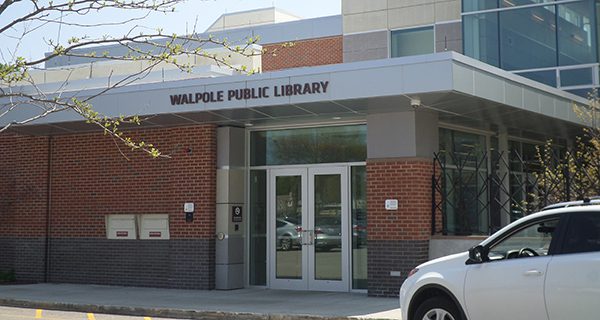By Amelia Tarallo
Hometown Weekly Staff
The first public library opened in Boston between 1711 and 1725. Since then, to say the least, things have changed. Entering the technological age, libraries have had to make great leaps to ensure they keep up with the profusion of new forms of knowledge. While some may still view libraries as places to search through stacks of books - which, of course, they are - they have also become havens of futuristic learning and living.
Hometown Weekly’s communities provide perfect examples of just such technologically-enhanced libraries.
The Wellesley Free Library, for example, is the home of several different robots, the most well-known being the NAO robots. The futuristic bots are easy to program using computer software called Choregraphe, which enables individuals to simply code the robots’ different behaviors. Those wishing to see the robots in action - which includes dancing and storytelling - can sign up for one of the demonstrations without having to worry about coding.
The library also welcomed the addition of an automated materials handler (AMH) last May. “The Library has a newly-designed drive-up/walk-up book drop, and the AMH with ‘Drop and Go’ capabilities can be seen in action through the glass viewing panel in the book drop. Behind-the-scenes tours are always available for anyone who wants a closer look,” writes Assistant Director Elise MacLennan of the Wellesley Free Library. This AMH saves library staff hours of work that they would have to spend sorting the various books returned to the library. Beyond that, of course, it is very entertaining for kids to watch their returned books processed via robot.
The Dover Town Library (DTL), meanwhile, offers a variety of technology for visitors to use. Perhaps the easiest to digest are the 40 Kindle Fires, preloaded with 1,600 different titles for people to borrow. Twice a week, the library offers sessions of virtual reality free-play. During this time, visitors age 10 and up can use the HTC Vive Virtual Reality equipment. “There are many different games to choose from, and we have a computer screen that shows what the player in the headset is seeing at all times,” explains Young Adult Librarian Angie Howes. “For many, this is their first time using a VR headset, so it’s nice to be able to do so under supervision, and for no cost. Many teens also get a kick out of watching their friends play through simulations.”
A 3D printer has also become a popular piece of equipment at the DTL. On Tuesday, January 7, for example, the library held a workshop to teach visitors how different 3D printers work, as well as how to use the TinkerCAD freeware to design small objects for print. The library charges $1 per meter of material when 3D printing. For only that small fee, there’s very little keeping someone from creating exactly what they want.
Neighboring Sherborn, meanwhile, continues a library construction project that will itself incorporate modern technology to enhance its offerings. The most current project schedule projects a completion by the end of summer 2020.
In Needham, much of the technology revolves around teaching the younger generation, pairing many of the programs with what the children are learning at school. In December 2016, the library received a Library Services Technology Act grant to build a STEAM Center. The STEAM Center now provides materials for children ages five and older to learn about coding, robots, electricity, and different forms of engineering. As it is the goal to keep adding new technology, the library expects to see the addition of two new Root robots. Among their myriad abilities, these robots will be able to drive across a white board by following a track created by a marker.
Older kids are welcomed to explore STEAM through library programs. The Needham branch of the Girls Who Code (GWC) Club is a perfect example: it encourages girls to learn about coding and eventually close the gender gap in the tech industry. “Options and tutorials provided by GWC this year include Python, Scratch, Javascript, and the apps Swift and Thunkable, as well as an opportunity to edit the website with HTML and CSS. This makes every year a uniquely different experience,” writes Children's Supervisor Paula Dugan of the Needham Library.
Opened in 2013, the new Westwood Library was built with evolving technology in mind, scoring 47 points on the LEED (Leadership in Energy and Environmental Design) scorecard. Built with sustainability in mind, the Westwood Library includes maximized natural light, energy-efficient LED and compact fluorescent lighting, low-flow plumbing fixtures, and further features to ensure that the library’s effect on the environment is as minimal as possible.
Walking into the Westwood Library, visitors can pop a book into the return window. If they wait a moment, they'll be able to watch as their materials are sorted. This piece of equipment is another type of AMH that uses radio frequency identification chips (RFID). “All circulating items have an RFID tag and a barcode attached to the item,” explained Westwood Library staff. “There is an RFID pad and antenna attached to a conveyor belt, and the barcode and RFID tag are linked so that the pad ‘reads’ the item. Software translates this to identify the item. This determines which bin the item should go to, based on the item’s location. As part of the RFID implementation, the staff here visited several local area libraries already using RFID … Once the time savings and benefit for staff became obvious, the former director and trustees decided to move forward with this as a part of the new building project.”
Nearby in Medfield, along with recently adding Hoopla to its digital library, the library’s encouragement of creativity has turned some of its once-empty rooms into creative spaces. The STEAM room (also known as Makerspace) includes equipment and supplies for different crafts and tech projects. Though there is a small fee to cover the use of materials, the sky's the limit in terms of what can be done in the Makerspace. There are two 3D printers, a sewing machine, a silhouette vinyl cutter, 3D pens, scanners, printers, and a VHS-to-DVD station. In short: there's very little a creative mind can't do in the Makerspace. Though popular amongst kids and their parents, the Makerspace has become a great place for problem solving. "My favorite project completed in the Makerspace: a patron had a pair of leather slippers that were very well-loved and had great sentimental value, but were completely falling apart,” writes Adult Services/Programming Librarian Bri Ozanne. “She came in not sure quite what do about it, so we got out the leather supplies and found a way to take them apart and sew them back together with new soles.” Whether it's creating something new or fixing something old, the Makerspae at Medfield is the perfect place to explore new technology to start or finish projects.
Opening in 2012, the new Walpole Public Library received gold LEED certification - the first for the town. The new building’s use of solar panels, a garden used for water management, and the use of recycled materials, as well as its use of natural light, all make use of modern technology to backbone a more environmentally-friendly building.
Along with its new warm, ecologically-conscious atmosphere, the library also employs technology to enhance patrons’ visits - and, in some cases, enable them to take advantage of the space’s offerings without ever leaving home. On its website, the library keeps a constantly updated list of New York Times bestsellers, as well as new books and videos that the library has received, to help visitors pick what they should check out during their next visits. The library also offers Hoopla, Kanopy, Overdrive, and RBDigital for library patrons who’d rather not leave home. All are perfect for day when one is too busy, too tired, or too put off by the New England weather to travel to the library. Interested parties may sign in with their library cards, and they’ll be entertained all day.
Much is made of print media’s decline, but this supposed decline has also been accompanied by a renaissance of technology. From the inclusion of 3D printers and streaming services to automated sorting, libraries now regard high-tech machinery and programming as pillars of their offerings. It’s never been just about the books, and today, it’s more apparent than ever. Take a visit to your local library today and see for yourself.






















